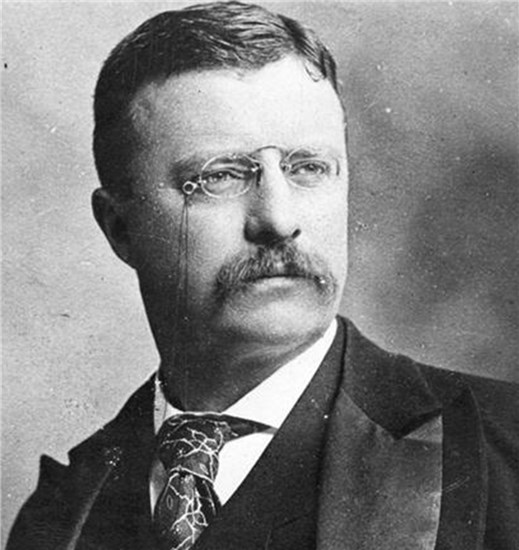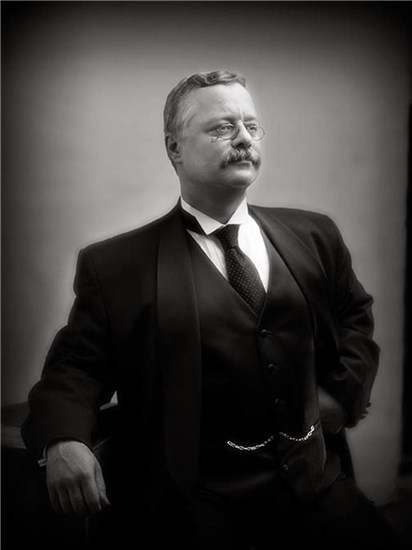

Theodore Roosevelt (1858-1919)
by Joe Wiegand
Sponsored by Randi Wolf and Art Wolf in honor and memory of their parents Louis and Vivian Wolf
By any measure, Theodore Roosevelt is a president deemed “Mt. Rushmore-worthy.” It is a wonder that a boy who grew up a weak and sickly asthmatic child in New York City, would eventually be our great Conservation President, famous for living and preaching the strenuous life, so strongly associated with the national parks and national forests of the western states.
As a young man, seeking solace and hard work after tragedy, TR became a cattle rancher in the Dakota Territory. He would eventually become our first Cowboy President, and when this president went on vacation, he did not go golfing. TR’s idea of vacation is well represented by his April 1905 bear hunting adventures in Colorado.
With famed Colorado hunting guide Johnny Goff by his side, TR arrived in Glenwood Springs and was soon hunting in the mountains of nearby New Castle. He wrote of the topography: “In the creek bottoms there were a good many ranches; but we only occasionally passed by these, on our way to our hunting grounds in the wilderness along the edge of the snow-line. The mountains crowded close together in chain, peak, and tableland; all the higher ones were wrapped in an unrent shroud of snow.” How appropriate that a May blizzard socked the hunting party at “Camp Roosevelt.”
While President, Theodore Roosevelt named by Executive Order or established with the assistance of Congress, over two hundred and thirty million acres of national parks, national forests, wildlife refuges, bird sanctuaries, and monuments. Among these are Mesa Verde National Park, established [1906], the Medicine Bow, San Isabel, and White River National Forests (1902), Gunnison, San Juan, and Uncompahgre National Forests (1905), and the Arapaho and Rio Grande National Forests (1908).
Theodore Roosevelt won the Nobel Peace Prize for settling the Russo-Japanese War with the Treaty of Portsmouth. He was posthumously awarded the Congressional Medal of Honor for his role in the Spanish American War. His Presidency was famous for advocating the Square Deal and a foreign policy summed up by the old African proverb, “Speak softly and carry a big stick; you will go far.”
He was the father of six children, an author of over thirty books, a world class ornithologist, and a man who, when he was serving as Governor of New York, held a meeting with the forester Gifford Pinchot, wherein, before they discussed forestry, they pushed the office furniture to the walls, rolled out a wrestling mat and proceeded to box and wrestle.
Guests at the High Plains Chautauqua are guaranteed a “bully time” when Theodore Roosevelt comes to life in a Salute to our national parks.
Recommended Reading
Brinkley, Douglas, The Wilderness Warrior: Theodore Roosevelt and the Crusade for America. Harper Perennial, 2009.
McCullough, David, Mornings on Horseback: The Story of an Extraordinary Family, a Vanished Way of Life and the Unique Child Who Became Theodore Roosevelt. Simon & Schuster, 1981.
Millard, Candice, The River of Doubt: Theodore Roosevelt’s Darkest Journey. Anchor, 2006.
Miller, John J., The Big Scrum: How Teddy Roosevelt Saved Football. Harper, 2011.
Roosevelt, Theodore, The Autobiography of Theodore Roosevelt. CreateSpace Independent Publishing Platform, 2013.
Joe Wiegand
Joe is a political science graduate of Sewanee, the University of the South, in Sewanee, Tennessee, and a former graduate assistant at the Center for Governmental Studies at Northern Illinois University, in DeKalb, Illinois. A member of Rotary International and the National Association for Interpretation Joe is a Harry S. Truman Scholar and a Thomas J. Watson Fellow. A former county commissioner in DeKalb County, Illinois, Joe and his family now reside near San Diego, California.
Joe has performed at the White House and in all fifty states, including the Chautauqua Institute of Chautauqua, New York, and the Winter Chautauqua in DeFuniak Springs, Florida. He has been featured in film and television, most recently in “The Men Who Built America” on the History Channel. Joe was the body model for the new TR statue at the American Museum of Natural History in New York City. His TR Tour is sponsored, in part, by the Theodore Roosevelt Medora Foundation of Medora, North Dakota. More information is available at www.teddyrooseveltshow.com
Bullet Points
-
Theodore Roosevelt, our great Conservation President, was also our first Cowboy President, familiar and comfortable with the pioneers, hunters, miners, and ranchers of the West.
-
A New Yorker, through and through, Roosevelt was also a cattle rancher in his youth, along the Little Missouri River in what was then Dakota Territory. Throughout his adult life, Roosevelt traveled through and hunted in the Rocky Mountains.
-
As President, Roosevelt’s most enduring domestic legacy is the preservation of the wildlife and natural resources of the nation, policies which saw their greatest impact in the Western states.
Quotes
-
“Speak softly and carry a big stick; you will go far.”
-
"There can be nothing in the world more beautiful than the Yosemite, the groves of the giant sequoias and redwoods, the Canyon of the Colorado, the Canyon of the Yellowstone, the Three Tetons; and our people should see to it that they are preserved for their children and their children's children forever, with their majestic beauty all unmarred."
-
"It is not what we have that will make us a great nation; it is the way in which we use it."
-
“If you could kick the person in the pants responsible for most of your trouble, you wouldn't sit for a month.”
-
“In life, as in football, the principle to follow is to hit the line hard.”
-
“Whenever you are asked if you can do a job, tell 'em, 'Certainly I can!' Then get busy and find out how to do it.”
-
“It is not the critic who counts; not the man who points out how the strong man stumbles, or where the doer of deeds could have done them better. The credit belongs to the man who is actually in the arena, whose face is marred by dust and sweat and blood; who strives valiantly; who errs, who comes short again and again, because there is no effort without error and shortcoming; but who does actually strive to do the deeds; who knows great enthusiasms, the great devotions; who spends himself in a worthy cause; who at the best knows in the end the triumph of high achievement, and who at the worst, if he fails, at least fails while daring greatly, so that his place shall never be with those cold and timid souls who neither know victory nor defeat.”
Timeline
1858 Born at 28 East 20th Street in New York City, New York.
1880 Graduates Phi Beta Kappa and Magna Cum Laude from Harvard, married Alice Hathaway Lee in Brookline, Massachusetts.
1881 Elected the youngest member of the New York General Assembly.
1883 Hunts bison along the Little Missouri River in the Badlands of Northwestern Dakota Territory, investing in a cattle ranch operation before returning to New York.
1884 TR’s widowed mother, Martha “Mittie” Bulloch Roosevelt dies of typhoid fever and TR’s wife, Alice, dies of Bright’s disease, in his arms, beneath the same roof, on the same day. Daughter Alice, born February 12, survives.
1884-86 TR’s cattle ranching days at the Maltese Cross and Elkhorn Ranches in the Badlands.
1886 Theodore Roosevelt marries Edith Kermit Carow at St. George’s Hanover Square, London, England. They have five more children.
1889 Appointed United States Civil Service Commissioner by President Benjamin Harrison. TR serves in the post through April 1895, the final two years under President Grover Cleveland.
1895 Appointed by the Mayor and elected by his fellow commissioners as President of the New York City Board of Police Commissioners, a post he holds through April, 1897.
1897 Begins his duties as Assistant Secretary of the Navy under President William McKinley.
1898 As commanding officer of the First United States Volunteer Cavalry, TR leads the charge up Kettle Hill in the Heights of San Juan surrounding the city of Santiago de Cuba assisting to bring a quick end to the Spanish-American War.
1898 Elected Governor of New York for a two-year term.
1900 Elected Vice-President of the United States on the Republican ticket with President McKinley.
1901 Theodore Roosevelt becomes 26th President of the United States on the death of President William McKinley, shot by an assassin in Buffalo, New York, on September 6.
1904 Elected President over Democrat Alton B. Parker.
1909 TR leaves the White House after seven and one half years as President, leaving a tremendous foreign and domestic policy legacy.
1919 Dies in his sleep at the family home, Sagamore Hill, Oyster Bay, Long Island, New York.